BIOTECHNOLOGY AND ITS APPLICATIONS for Class 12 BIOLOGY
INTRODUCTION
- In the last chapter we discussed about principles and processes of biotechnology and we shall discuss about the several applications of biotechnology in agriculture, in medicines, creating transgenic animals and plants, and in molecular diagnosis of diseases and then at last we shall discuss about the ethical issues related with several experiments followed by a brief discussion on biopatent, biopiracy. Then we will be closing with a short discussion on biowar.
INTRODUCTION
- In the last chapter we discussed about principles and processes of biotechnology and we shall discuss about the several applications of biotechnology in agriculture, in medicines, creating transgenic animals and plants, and in molecular diagnosis of diseases and then at last we shall discuss about the ethical issues related with several experiments followed by a brief discussion on biopatent, biopiracy. Then we will be closing with a short discussion on biowar.
INTRODUCTION
- In the last chapter we discussed about principles and processes of biotechnology and we shall discuss about the several applications of biotechnology in agriculture, in medicines, creating transgenic animals and plants, and in molecular diagnosis of diseases and then at last we shall discuss about the ethical issues related with several experiments followed by a brief discussion on biopatent, biopiracy. Then we will be closing with a short discussion on biowar.
CHAPTER WEIGHTAGE
- Usually more questions come from this chapter because applications of anything that we study are far much more important than the process itself. Questions are mainly on gene therapy, genetically engineered insulin and RNAi. one out of these 3 topics is asked every year without fail.
CHAPTER WEIGHTAGE
- Usually more questions come from this chapter because applications of anything that we study are far much more important than the process itself. Questions are mainly on gene therapy, genetically engineered insulin and RNAi. one out of these 3 topics is asked every year without fail.
CHAPTER WEIGHTAGE
- Usually more questions come from this chapter because applications of anything that we study are far much more important than the process itself. Questions are mainly on gene therapy, genetically engineered insulin and RNAi. one out of these 3 topics is asked every year without fail.
APPLICATIONS OF BIOTECHNOLOGY IN AGRICULTURE
- Last chapter me humne dekha tha ki biotechnology me kya kya processes hai and kaisey karte hain, kya principles and tools hai but ab iss chapter me hum biotechnology ki applications discuss karenge.
- Golden Rice, ek genetically engineered rice ki variety hai jisme humne 'beta'-carotene ka gene dala hua hai. Toh iss plant ke rice grains me 'beta'-carotene ka productions hota hai, jo ki yellow colour ka pigment hai jiske karan is rice ka colour white ki jagah yellow ho gya. So this was named as golden rice. 'beta'-carotene , vitamin A ka precursor hai toh iss golden rice ke consumption se Vitamin A ki deficiency dur ho jati hai jiske karan Vitamin A ki deficiency se hone wali diseases jaise ki night blindness, dry eyes, dry skin, infertility vgarah nahi hogi.
- Transgenic plants create karne ke liye hum Agrobacterium tumefaciens bacteria ke plasmid DNA ko as a vector use karte hain. Generally iss bacteria ka plasmid, plants cells me ek DNA sequence insert karta hai which is known as T-DNA. Ab plant me yeah T-DNA tumour induce karwata hai toh plasmid ka naam humne tumour inducing plasmid rakh diya.
- Ab pura ka pura plamid DNA toh plant cell ke genome me insert nahi kiya jata par T-DNA jarur jakr plant cell ke DNA ke sath integrate karta hai.
- Ab hume jo bhi bhi transgene (like gene for 'beta'-carotene) plant cell me dalna hai usko hum iss bacteria ke plasmid ki T-DNA ke beech me daalte hai taki jab bacterial plasmid apna T-DNA plant me insert karega toh uss waqt humara transgene insert ho rha hoga and tumour nhi bn payega kyunki T-DNA ke beech me transgene hony ke karan ab T-DNA split ho chuka hai and it no longer has the ability to induce the tumourigenesis in the plant cells.
- Bacillus thuringiensis ek bacteria hai jo ek aisa crystalline protein bnata hai jo keval kuch insects vgarah ko marta hai and baki organisms ke uper iska koi asar nahi hota.
- 2-3 type ka toxin banta hai ek hi bacteria se and we have different genetic sequences for each one. Or jo gene is insecticidal toxin ko code karta hai uska naam hai Cry gene.
- Alag alag Cry genes alag alag insects ko marte hain.
- Hota yeah hai ki bacteria iss toxic protein ko inactivate form me secrete karta hai lekin jab insect isko ingest krta hai toh uss insect ki gut ke alkaline pH ke karan yeah toxic protein activate ho jata hai and gut ke epithelium tissue ko break (lysis) karna shuru kar deta hai jissey insect ki gut (stomach and intestines) ke sab cells tut gye and wo ab khana ni kha payega toh kuch dino me bechara bhukh se mar jata hai.
- Bt-toxin is generally effective against lepidopterans, coleopterans and corn borer.
- RNAi ek aisa process hai jo naturally eukaryotic cells me as a self defense mechanism ki tarah kam karta hai. Humne kuch eukaryotic cells me isko study kiya but sabhi eukaryotic cells me yeah naturally nahi hota.
- RNAi me hota yeah hai ki ek ssRNA dusre ssRNA ki translation ko rok deta hai that is silencing that gene.
- Ab plants me RNAi nahi hota jiske karan unme infections hote rehte hai and yeah specifically economic crops jaisey ki tobacco ke case me economic way me bahut nuksaan karta hai qnki infection ke karan crop ka yield decrease ho jata hai.
- Tobacco ke case me infection ek nematode (Meloidogyne incognita) ka hota hai. Yeah nematode me ek gene hota hai jiske protein ke karan tobacco plant ki roots me tumour bn jata hai.
- Toh ab hume iss tumour inducing mRNA ki translation ko rokna hai yani ki isko silence karna hai. Toh iske liye hum tobacco plants me genetic engineering krke unme RNAi ko initiate karwate hai.
- Hum Agrobacterium tumefaciens ke plasmid ko use karke, nematode ke genes plants me iss tarekey se daalte hai ki plant cell me unki transcription ke baad 2 aisey RNA strands bante hain jo ek dusre ke complementary ho and wo dono apas me pairing karke dsRNA ban de.
- Plant cell me generally koi dsRNA hota nahi toh issey dekh plant sochega ki yeah kya cheez aagyi alag si, isko degrade karo yrr, toh plant cell dicer protein ko bhejega ki is dsRNA ko degrade kardo. Toh dicer us lambe dsRNA ko chote chote dsRNA me tod deta hai jinko small interfering RNA / siRNA kehte hai
- Then yeah RISC (RNA induced silencing complex) ke sath combine hote hai and RISC unzips the double stranded siRNA to form a RISC silencing complexes.
- Ab jab nematode aakr plant ko khana shuru karega toh yeah silencing complex usme jakr, tumour mRNA ke sath complimentary base pair bnata hai and then RISC uss target mRNA ko degrade kr deta hai. Plant me tumour nahi banega toh nematode ko khana ni milna and wo kuch time me mar jayega.
- Neeche wale section me humne bahut sare transgenic plants jaisey ki Bt-maize, Transgenic Brassica napus for production of hirudin vgarah discuss kiye hain. These will not be asked in the cbse exam but upar wale do section : bt-Cotton and RNAi are generally asked so pay attention to them.
Yeah pehla section deal karega with the applications of biotechnology in agriculture.
Now question arises, how do we create these transgenic plants?
Bt-Cotton
RNAi
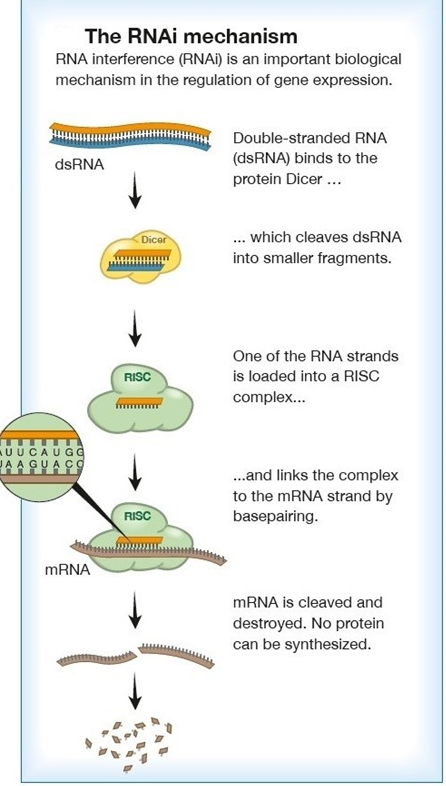
APPLICATIONS OF BIOTECHNOLOGY IN AGRICULTURE
- The main aim of biotechnology is to increase the yield to meet the demands of increasing population while reducing the use of harmful chemicals (chemical fertilisers, insecticides and pesticides).
- Norman Ernest Borlaug is the “father of the green revolution”.
- M.S.Swaminathan is the “father of green revolution in India”. He introduced mexican wheat varieties in India and also developed the short duration, high yielding varieties of rice including the basmativariety.
- Plants, bacteria, fungi, animals whose genes have been altered by manipulation through the genetic engineering are known as genetically modified organisms (GMO) or transgenic organisms.
- The production of transgenic plants is based upon the tumor inducing (Ti) plasmid of soil bacterium agrobacterium tumefaciens which is generally known as natural genetic engineer. As the name suggests the Tumor-inducing plasmid induces the formation of a cancerous growth known as crown gall tumor . This bacteria has the natural ability to infect a plant cell quite efficiently so if we can remove it's tumour inducing DNA segment, we can use Agrobacterium tumefaciens as an efficient vector for transferring the Gene of Interest into a plant cell to create transgenic plants.
- The part of the bacteria that is transferred into the plant cell is known as T-DNA. So we can insert our gene of interest (transgene) into the T-DNA so that upon infection of the bacteria, the transgene will be transferred to the plant cell.
- The plant cells which have been infected with the bacteria are cultured and induced to multiply and differentiate to form plantlets. Plantlets are then transferred into the soil where they grow into mature plants carrying the foreign gene segment throughout the new plant.
- BT stands for bacillus thuringiensis, battaglia which produces toxins that specifically kill insects like budworms, tobacco worms and armyworms along with Beetles and flies and mosquitoes.
- This insecticidal protein is secreted in inactive form by the bacteria in the form of crystals. Toxic protein gets activated in the alkaline gut of these insects. The activated toxin binds to the surface of the epithelial cells and creates pores which causes cell lysis and eventually cause death of the insect.
- The BT toxin is encoded by the cry genes and we have different types of cry genes depending upon whether they work against ball worms or other insects.The talks encoded by cryIAc and cryIIAb control the cotton ball worms and that of cryIAb controls the corn borer.
- The nematode Meloidogyne incognitainfects the roots of tobacco plants and causes great losses in the yield.
- So to protect the plant against this nematode we take help of RNAi which is a process in which we silence a specific gene by using RNA. This all loosely translates to “stop the translation of a particular mRNA with help of another RNA molecule”.
- Now, this nematode causes tumours in the roots of tobacco plants for which a specific tumour protein is responsible. What we do is that if somehow we can stop translation of that tumour causing mRNA (this is where RNAi comes into play) we can actually save the tobacco plant from manifestation of nematode and soon the nematode will die because it won’t get any food from the plant unless it forms the tumours in the roots of tobacco plant.
- Cells usually do not have dsRNA so if a cell has dsRNA, that will be cleaved into smaller fragments of 20-25 base pairs. Just remember this concept of Dicer proteins for the future discussion.
- Using Agrobacterium tumefaciens we insert the nematode specific genes into the plant cells so that now during transcription of the nematode specific genes in the plant, there will be formation of two type of RNAs : sense and antisense, which will pair to form a dsRNA. This is where the story begins.
- The plant cell senses that somewhere in the cell a dsRNA is formed and directs the dicer protein to cut the long dsRNA into small dsRNA molecules. Dicer does what’s expected of it and now the plant cell has small dsRNA molecules.
- Now refer to the image given below. After the action of dicer protein, some other proteins (like slicer protein and argonaute protein remembering names of these proteins is absolutely not necessary.) come together to form a RNA induced silencing complex (RISC - protein) which will degrade the dsRNA into ssRNA associated with the RISC proteins and forms another complex known as si-RNA-mRNA complex (siRNA = small interfering RNA) which is ingested by the nematode when it infects the plants and tries to it.
- Inside the nematode, the si-RNA-mRNA complex will bind to its complementary ssRNA of nematode. It is this ssRNA in the nematode whose translation will form a protein responsible for causing tumour in the plant cells. So when si-RNA-mRNA complex binds to the ssRNA of a nematode, that gene will not be transcribed or in other words is silenced.
- Post harvest losses were great in the tomatoes due to over ripening by the action of enzyme polygalacturonase, an enzyme which breaks down cell wall (ripening of tomato).
- Antisense RNA against the enzyme inhibits the synthesis of this enzyme thus delayed ripening. Thus these tomatoes have longer shelf life.
- This is a transgenic variety of rice which contains more quantity of beta carotene (precursor of vitamin A).
- Due to the high level of beta carotene this variety of rice is somewhat yellowish in colour, that is why we call it “golden rice”.
- After ingestion the beta carotene will be converted into vitamin A in the body thus preventing night blindness and skin diseases which generally occur due to deficiency of vitamin A.
- Bt-tobacco has been created to prevent damages from insects and mosquitoes etc. This is similar to the Bt-cotton.
- Hirudin is an anticoagulant protein which prevents formation of blood clots so it has major applications during long surgeries. This protein is naturally produced by the leech - Hirudinaria so we took the gene responsible for its production in the leech and transferred it toBrassica napus plant, where hirudin accumulates in the seeds. It is extracted, purified and used as medicine without the need of harvesting leeches for its production.
- Transgenic crops are pest resistant so they reduce the use of chemical pesticides.
- GM crops are more resistant to abiotic stresses like drought, cold, salt, heat etc.
- Reduced post harvest losses.
- Increased efficiency of mineral usage which prevents early exhaustion of soil fertility.
- Increased nutritional value.
- They are herbicide resistant.
- GM crops which are resistant to disease caused by common viruses, fungi and bacterias are also under development.
- PhytoremediationPlants like poplar are genetically modified to clean up heavy metal pollution from contaminated soil.
- Unintended harm to other organisms : Pollen from Bt corn is blown by wind on to milkweed plants. Monarch butterflies feed on milkweed plants and this bt toxin is effective against them also. So it caused a high mortality rate of monarch butterflies.
- Just like bacterias are becoming resistant to most of the antibiotics now a days, people fear that the insects will become resistant to Bt-toxin.
- Another concern is that herbicide resistance might cross breed with the weeds making herbicide resistant weeds known as “superweeds”.
- GM food crops might lead to allergies in humans.
- The bacteria in the human gut could take up the transgene from GM food sources.
- GM crops are costly so there are economic concerns regarding bringing a GM crop to market.
Production Of Transgenic Plants

Transgenic Plants
Plants which carry a foreign gene segment (transgene) in them are known as transgenic plants.
1.) Bt-cotton (Insect resistance plant)

2.) Pest Resistance Plans (Protection Against Nematodes)
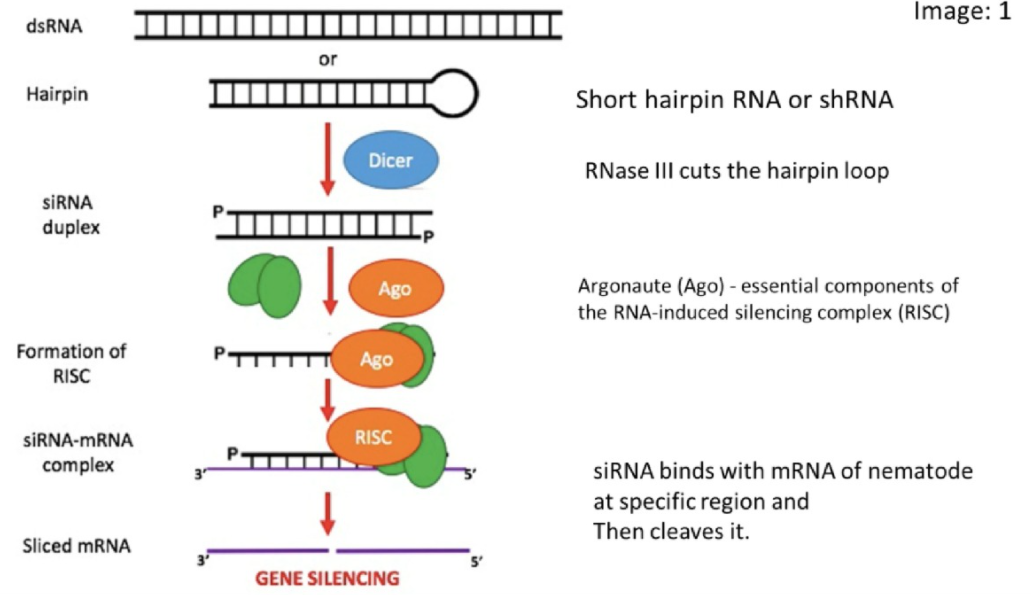
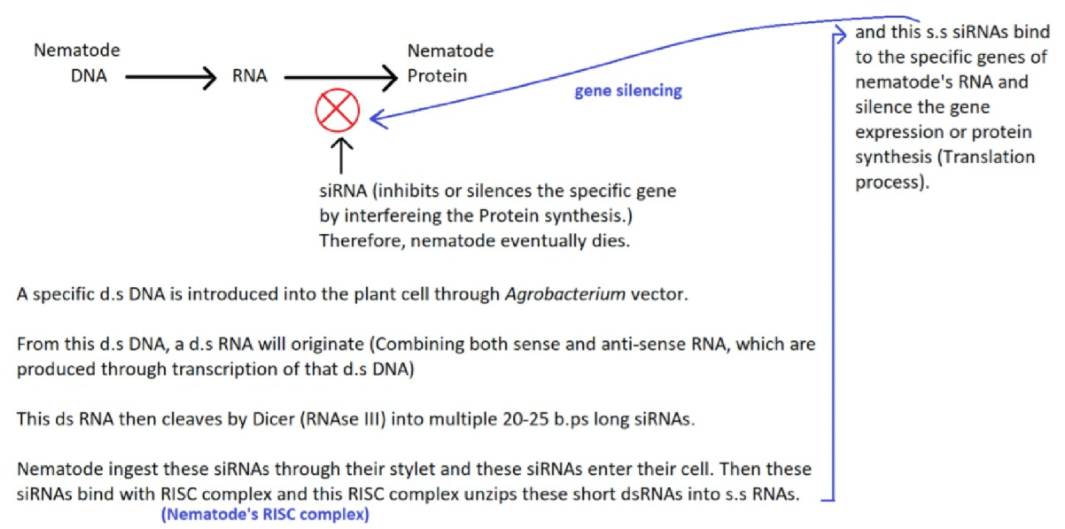
The nematode Meloidogyne incognita is shown below :
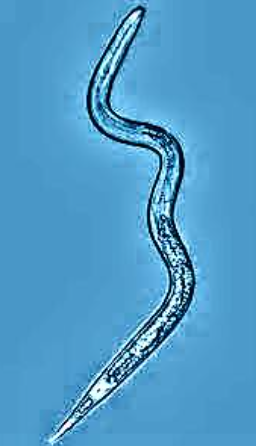
3.) Transgenic Tomatoes
4.) Golden Rice
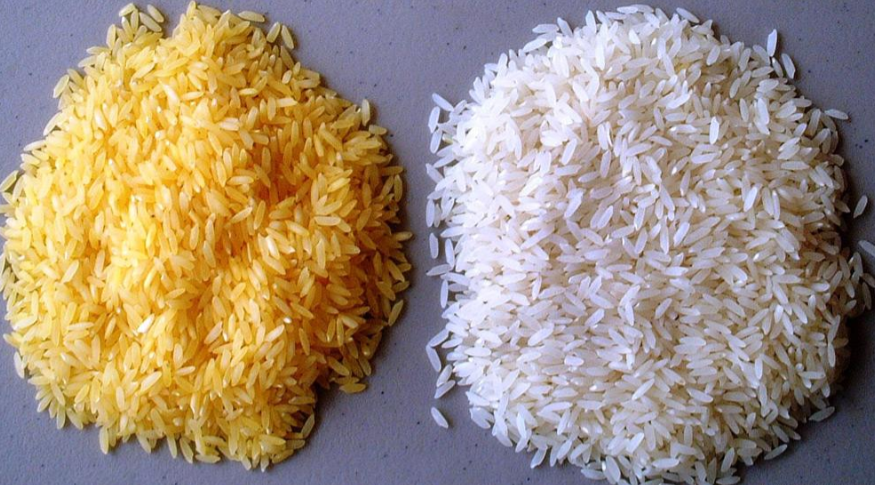
Pest resistant corn (transgenic) vs. non transgenic corn :

5.) Transgenic Tobacco
Resistance of transgenic tobacco plants against E. cichoracearum
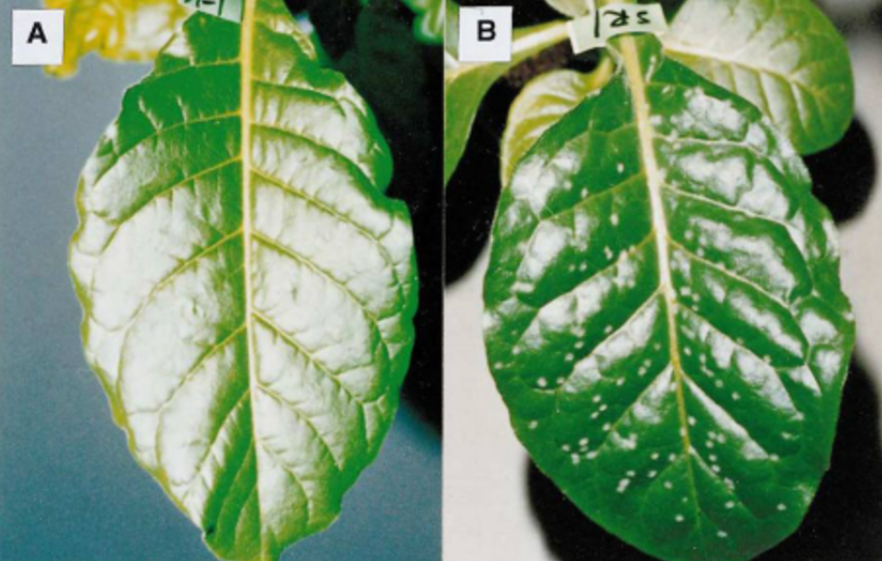
6.) Transgenic Brassica napus

Advantages of Transgenic Plants
Disadvantages of Transgenic Plants
APPLICATIONS OF BIOTECHNOLOGY IN AGRICULTURE
- The main aim of biotechnology is to increase the yield to meet the demands of increasing population while reducing the use of harmful chemicals (chemical fertilisers, insecticides and pesticides).
- Norman Ernest Borlaug is the “father of the green revolution”.
- M.S.Swaminathan is the “father of green revolution in India”. He introduced mexican wheat varieties in India and also developed the short duration, high yielding varieties of rice including the basmativariety.
- Plants, bacteria, fungi, animals whose genes have been altered by manipulation through the genetic engineering are known as genetically modified organisms (GMO) or transgenic organisms.
- The production of transgenic plants is based upon the tumor inducing (Ti) plasmid of soil bacterium agrobacterium tumefaciens which is generally known as natural genetic engineer. As the name suggests the Tumor-inducing plasmid induces the formation of a cancerous growth known as crown gall tumor . This bacteria has the natural ability to infect a plant cell quite efficiently so if we can remove it's tumour inducing DNA segment, we can use Agrobacterium tumefaciens as an efficient vector for transferring the Gene of Interest into a plant cell to create transgenic plants.
- The part of the bacteria that is transferred into the plant cell is known as T-DNA. So we can insert our gene of interest (transgene) into the T-DNA so that upon infection of the bacteria, the transgene will be transferred to the plant cell.
- The plant cells which have been infected with the bacteria are cultured and induced to multiply and differentiate to form plantlets. Plantlets are then transferred into the soil where they grow into mature plants carrying the foreign gene segment throughout the new plant.
- BT stands for bacillus thuringiensis, battaglia which produces toxins that specifically kill insects like budworms, tobacco worms and armyworms along with Beetles and flies and mosquitoes.
- This insecticidal protein is secreted in inactive form by the bacteria in the form of crystals. Toxic protein gets activated in the alkaline gut of these insects. The activated toxin binds to the surface of the epithelial cells and creates pores which causes cell lysis and eventually cause death of the insect.
- The BT toxin is encoded by the cry genes and we have different types of cry genes depending upon whether they work against ball worms or other insects.The talks encoded by cryIAc and cryIIAb control the cotton ball worms and that of cryIAb controls the corn borer.
- The nematode Meloidogyne incognitainfects the roots of tobacco plants and causes great losses in the yield.
- So to protect the plant against this nematode we take help of RNAi which is a process in which we silence a specific gene by using RNA. This all loosely translates to “stop the translation of a particular mRNA with help of another RNA molecule”.
- Now, this nematode causes tumours in the roots of tobacco plants for which a specific tumour protein is responsible. What we do is that if somehow we can stop translation of that tumour causing mRNA (this is where RNAi comes into play) we can actually save the tobacco plant from manifestation of nematode and soon the nematode will die because it won’t get any food from the plant unless it forms the tumours in the roots of tobacco plant.
- Cells usually do not have dsRNA so if a cell has dsRNA, that will be cleaved into smaller fragments of 20-25 base pairs. Just remember this concept of Dicer proteins for the future discussion.
- Using Agrobacterium tumefaciens we insert the nematode specific genes into the plant cells so that now during transcription of the nematode specific genes in the plant, there will be formation of two type of RNAs : sense and antisense, which will pair to form a dsRNA. This is where the story begins.
- The plant cell senses that somewhere in the cell a dsRNA is formed and directs the dicer protein to cut the long dsRNA into small dsRNA molecules. Dicer does what’s expected of it and now the plant cell has small dsRNA molecules.
- Now refer to the image given below. After the action of dicer protein, some other proteins (like slicer protein and argonaute protein remembering names of these proteins is absolutely not necessary.) come together to form a RNA induced silencing complex (RISC - protein) which will degrade the dsRNA into ssRNA associated with the RISC proteins and forms another complex known as si-RNA-mRNA complex (siRNA = small interfering RNA) which is ingested by the nematode when it infects the plants and tries to it.
- Inside the nematode, the si-RNA-mRNA complex will bind to its complementary ssRNA of nematode. It is this ssRNA in the nematode whose translation will form a protein responsible for causing tumour in the plant cells. So when si-RNA-mRNA complex binds to the ssRNA of a nematode, that gene will not be transcribed or in other words is silenced.
- Post harvest losses were great in the tomatoes due to over ripening by the action of enzyme polygalacturonase, an enzyme which breaks down cell wall (ripening of tomato).
- Antisense RNA against the enzyme inhibits the synthesis of this enzyme thus delayed ripening. Thus these tomatoes have longer shelf life.
- This is a transgenic variety of rice which contains more quantity of beta carotene (precursor of vitamin A).
- Due to the high level of beta carotene this variety of rice is somewhat yellowish in colour, that is why we call it “golden rice”.
- After ingestion the beta carotene will be converted into vitamin A in the body thus preventing night blindness and skin diseases which generally occur due to deficiency of vitamin A.
- Bt-tobacco has been created to prevent damages from insects and mosquitoes etc. This is similar to the Bt-cotton.
- Hirudin is an anticoagulant protein which prevents formation of blood clots so it has major applications during long surgeries. This protein is naturally produced by the leech - Hirudinaria so we took the gene responsible for its production in the leech and transferred it toBrassica napus plant, where hirudin accumulates in the seeds. It is extracted, purified and used as medicine without the need of harvesting leeches for its production.
- Transgenic crops are pest resistant so they reduce the use of chemical pesticides.
- GM crops are more resistant to abiotic stresses like drought, cold, salt, heat etc.
- Reduced post harvest losses.
- Increased efficiency of mineral usage which prevents early exhaustion of soil fertility.
- Increased nutritional value.
- They are herbicide resistant.
- GM crops which are resistant to disease caused by common viruses, fungi and bacterias are also under development.
- PhytoremediationPlants like poplar are genetically modified to clean up heavy metal pollution from contaminated soil.
- Unintended harm to other organisms : Pollen from Bt corn is blown by wind on to milkweed plants. Monarch butterflies feed on milkweed plants and this bt toxin is effective against them also. So it caused a high mortality rate of monarch butterflies.
- Just like bacterias are becoming resistant to most of the antibiotics now a days, people fear that the insects will become resistant to Bt-toxin.
- Another concern is that herbicide resistance might cross breed with the weeds making herbicide resistant weeds known as “superweeds”.
- GM food crops might lead to allergies in humans.
- The bacteria in the human gut could take up the transgene from GM food sources.
- GM crops are costly so there are economic concerns regarding bringing a GM crop to market.
Production Of Transgenic Plants

Transgenic Plants
Plants which carry a foreign gene segment (transgene) in them are known as transgenic plants.
1.) Bt-cotton (Insect resistance plant)

2.) Pest Resistance Plans (Protection Against Nematodes)


The nematode Meloidogyne incognita is shown below :

3.) Transgenic Tomatoes
4.) Golden Rice

Pest resistant corn (transgenic) vs. non transgenic corn :

5.) Transgenic Tobacco
Resistance of transgenic tobacco plants against E. cichoracearum

6.) Transgenic Brassica napus

Advantages of Transgenic Plants
Disadvantages of Transgenic Plants
APPLICATIONS OF BIOTECHNOLOGY IN AGRICULTURE
- The main aim of biotechnology is to increase the yield to meet the demands of increasing population while reducing the use of harmful chemicals (chemical fertilisers, insecticides and pesticides).
- Norman Ernest Borlaug is the “father of the green revolution”.
- M.S.Swaminathan is the “father of green revolution in India”. He introduced mexican wheat varieties in India and also developed the short duration, high yielding varieties of rice including the basmativariety.
- Plants, bacteria, fungi, animals whose genes have been altered by manipulation through the genetic engineering are known as genetically modified organisms (GMO) or transgenic organisms.
- The production of transgenic plants is based upon the tumor inducing (Ti) plasmid of soil bacterium agrobacterium tumefaciens which is generally known as natural genetic engineer. As the name suggests the Tumor-inducing plasmid induces the formation of a cancerous growth known as crown gall tumor . This bacteria has the natural ability to infect a plant cell quite efficiently so if we can remove it's tumour inducing DNA segment, we can use Agrobacterium tumefaciens as an efficient vector for transferring the Gene of Interest into a plant cell to create transgenic plants.
- The part of the bacteria that is transferred into the plant cell is known as T-DNA. So we can insert our gene of interest (transgene) into the T-DNA so that upon infection of the bacteria, the transgene will be transferred to the plant cell.
- The plant cells which have been infected with the bacteria are cultured and induced to multiply and differentiate to form plantlets. Plantlets are then transferred into the soil where they grow into mature plants carrying the foreign gene segment throughout the new plant.
- BT stands for bacillus thuringiensis, battaglia which produces toxins that specifically kill insects like budworms, tobacco worms and armyworms along with Beetles and flies and mosquitoes.
- This insecticidal protein is secreted in inactive form by the bacteria in the form of crystals. Toxic protein gets activated in the alkaline gut of these insects. The activated toxin binds to the surface of the epithelial cells and creates pores which causes cell lysis and eventually cause death of the insect.
- The BT toxin is encoded by the cry genes and we have different types of cry genes depending upon whether they work against ball worms or other insects.The talks encoded by cryIAc and cryIIAb control the cotton ball worms and that of cryIAb controls the corn borer.
- The nematode Meloidogyne incognitainfects the roots of tobacco plants and causes great losses in the yield.
- So to protect the plant against this nematode we take help of RNAi which is a process in which we silence a specific gene by using RNA. This all loosely translates to “stop the translation of a particular mRNA with help of another RNA molecule”.
- Now, this nematode causes tumours in the roots of tobacco plants for which a specific tumour protein is responsible. What we do is that if somehow we can stop translation of that tumour causing mRNA (this is where RNAi comes into play) we can actually save the tobacco plant from manifestation of nematode and soon the nematode will die because it won’t get any food from the plant unless it forms the tumours in the roots of tobacco plant.
- Cells usually do not have dsRNA so if a cell has dsRNA, that will be cleaved into smaller fragments of 20-25 base pairs. Just remember this concept of Dicer proteins for the future discussion.
- Using Agrobacterium tumefaciens we insert the nematode specific genes into the plant cells so that now during transcription of the nematode specific genes in the plant, there will be formation of two type of RNAs : sense and antisense, which will pair to form a dsRNA. This is where the story begins.
- The plant cell senses that somewhere in the cell a dsRNA is formed and directs the dicer protein to cut the long dsRNA into small dsRNA molecules. Dicer does what’s expected of it and now the plant cell has small dsRNA molecules.
- Now refer to the image given below. After the action of dicer protein, some other proteins (like slicer protein and argonaute protein remembering names of these proteins is absolutely not necessary.) come together to form a RNA induced silencing complex (RISC - protein) which will degrade the dsRNA into ssRNA associated with the RISC proteins and forms another complex known as si-RNA-mRNA complex (siRNA = small interfering RNA) which is ingested by the nematode when it infects the plants and tries to it.
- Inside the nematode, the si-RNA-mRNA complex will bind to its complementary ssRNA of nematode. It is this ssRNA in the nematode whose translation will form a protein responsible for causing tumour in the plant cells. So when si-RNA-mRNA complex binds to the ssRNA of a nematode, that gene will not be transcribed or in other words is silenced.
- Post harvest losses were great in the tomatoes due to over ripening by the action of enzyme polygalacturonase, an enzyme which breaks down cell wall (ripening of tomato).
- Antisense RNA against the enzyme inhibits the synthesis of this enzyme thus delayed ripening. Thus these tomatoes have longer shelf life.
- This is a transgenic variety of rice which contains more quantity of beta carotene (precursor of vitamin A).
- Due to the high level of beta carotene this variety of rice is somewhat yellowish in colour, that is why we call it “golden rice”.
- After ingestion the beta carotene will be converted into vitamin A in the body thus preventing night blindness and skin diseases which generally occur due to deficiency of vitamin A.
- Bt-tobacco has been created to prevent damages from insects and mosquitoes etc. This is similar to the Bt-cotton.
- Hirudin is an anticoagulant protein which prevents formation of blood clots so it has major applications during long surgeries. This protein is naturally produced by the leech - Hirudinaria so we took the gene responsible for its production in the leech and transferred it toBrassica napus plant, where hirudin accumulates in the seeds. It is extracted, purified and used as medicine without the need of harvesting leeches for its production.
- Transgenic crops are pest resistant so they reduce the use of chemical pesticides.
- GM crops are more resistant to abiotic stresses like drought, cold, salt, heat etc.
- Reduced post harvest losses.
- Increased efficiency of mineral usage which prevents early exhaustion of soil fertility.
- Increased nutritional value.
- They are herbicide resistant.
- GM crops which are resistant to disease caused by common viruses, fungi and bacterias are also under development.
- PhytoremediationPlants like poplar are genetically modified to clean up heavy metal pollution from contaminated soil.
- Unintended harm to other organisms : Pollen from Bt corn is blown by wind on to milkweed plants. Monarch butterflies feed on milkweed plants and this bt toxin is effective against them also. So it caused a high mortality rate of monarch butterflies.
- Just like bacterias are becoming resistant to most of the antibiotics now a days, people fear that the insects will become resistant to Bt-toxin.
- Another concern is that herbicide resistance might cross breed with the weeds making herbicide resistant weeds known as “superweeds”.
- GM food crops might lead to allergies in humans.
- The bacteria in the human gut could take up the transgene from GM food sources.
- GM crops are costly so there are economic concerns regarding bringing a GM crop to market.
Production Of Transgenic Plants

Transgenic Plants
Plants which carry a foreign gene segment (transgene) in them are known as transgenic plants.
1.) Bt-cotton (Insect resistance plant)

2.) Pest Resistance Plans (Protection Against Nematodes)


The nematode Meloidogyne incognita is shown below :

3.) Transgenic Tomatoes
4.) Golden Rice

Pest resistant corn (transgenic) vs. non transgenic corn :

5.) Transgenic Tobacco
Resistance of transgenic tobacco plants against E. cichoracearum

6.) Transgenic Brassica napus

Advantages of Transgenic Plants
Disadvantages of Transgenic Plants
TRANSGENIC ANIMALS
- Animals which carry a foreign gene are known as transgenic animals.
- Transgenic animals are specifically developed to study how a particular gene is regulated.
- Many transgenic animals are used as a model for a particular disease to see how that disease affects the organism and how a particular medicine will react.
- Spare parts like heart, liver of pig for human use can be grown by genetic engineering.
- Transgenic animals are produced that synthesise specific biological products required to cure some of human diseases like the production of alpha-1-antitrypsin (via transgenic cow) is used to treat emphysema. In this case the transgenic cow will act as a bioreactor to produce the antitrypsin protein which will be purified from its milk.
- Clones of animals can be produced.
- Transgenic Mice
Mouse is the most preferred mammal for genetic engineering studies. Many transgenic mouse and knockout mice have been created to study the working mechanism of particular genes or diseases. - Transgenic Goats : are being used as bioreactors for various biomolecules specially the production of spider silk which is purified from goat's milk.
- Transgenic Sheep : Transgenic sheeps have been prepared to produce biomolecules like, blood clotting factor IX, antitrypsin etc. by fusing the transgenes into the mammary glands.
- Transgenic Chicken : Transgenic chickens resistant to the pathogen Avian Leukosis Virus (ALV) have been produced because ALV is a serious pathogen of chickens.
- Dogie a transgenic dog with super smelling power has been created which was used during the attack on world trade center in 2001 to recover injured people/ casualties after the building collapsed.
- ANDI : was the first transgenic monkey with DNA of fluorescent jellyfish in its genome.
- Transgenic Cattles : The 2 main objectives to produce transgenic cows are : increased milk/meat production and molecular farming (to use cattles as bioreactors). First transgenic cow is Rosie.
- Transgenic Pigs : Transgenic pigs have been created for increased meat production and to produce spare hearts, liver etc to cure disease where the last choice of treatment is usually organ transplantation. Pigs have been used for this purpose because the size of pigs organ, their morphology and anatomy are quite similar to humans.
Advantages Of Transgenic Animals
Examples Of Transgenic Animals
The photo shows two transgenic mice positioned either side of a plain mouse. The transgenic mice have been genetically modified so that they carry a green fluorescent protein which glows green under blue light.


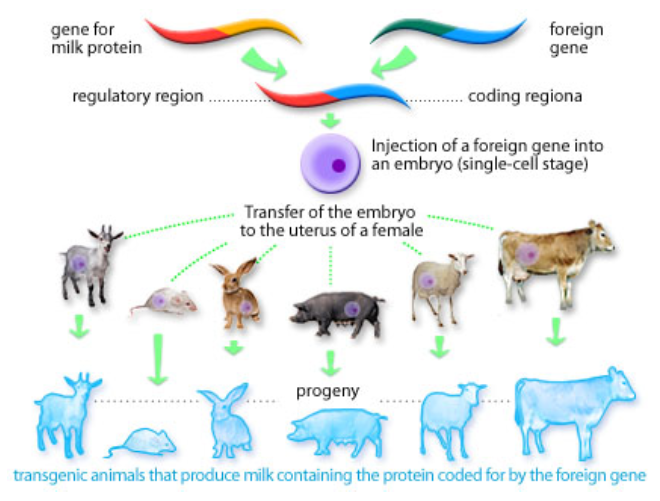
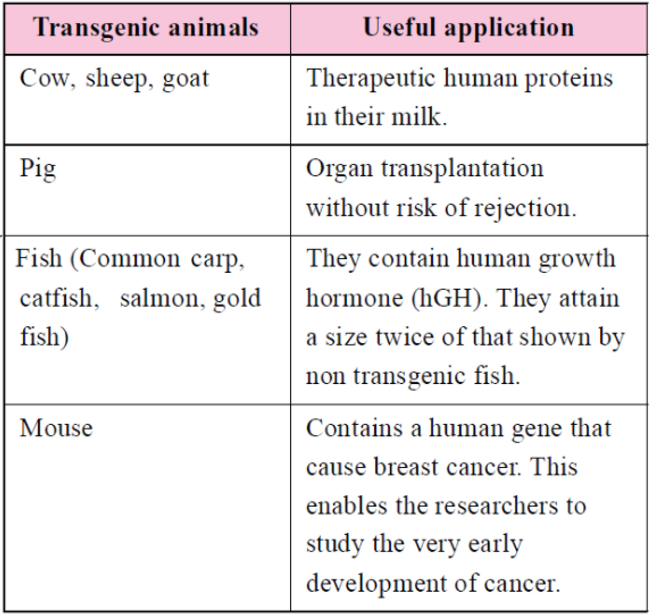
TRANSGENIC ANIMALS
- Animals which carry a foreign gene are known as transgenic animals.
- Transgenic animals are specifically developed to study how a particular gene is regulated.
- Many transgenic animals are used as a model for a particular disease to see how that disease affects the organism and how a particular medicine will react.
- Spare parts like heart, liver of pig for human use can be grown by genetic engineering.
- Transgenic animals are produced that synthesise specific biological products required to cure some of human diseases like the production of alpha-1-antitrypsin (via transgenic cow) is used to treat emphysema. In this case the transgenic cow will act as a bioreactor to produce the antitrypsin protein which will be purified from its milk.
- Clones of animals can be produced.
- Transgenic Mice
Mouse is the most preferred mammal for genetic engineering studies. Many transgenic mouse and knockout mice have been created to study the working mechanism of particular genes or diseases. - Transgenic Goats : are being used as bioreactors for various biomolecules specially the production of spider silk which is purified from goat's milk.
- Transgenic Sheep : Transgenic sheeps have been prepared to produce biomolecules like, blood clotting factor IX, antitrypsin etc. by fusing the transgenes into the mammary glands.
- Transgenic Chicken : Transgenic chickens resistant to the pathogen Avian Leukosis Virus (ALV) have been produced because ALV is a serious pathogen of chickens.
- Dogie a transgenic dog with super smelling power has been created which was used during the attack on world trade center in 2001 to recover injured people/ casualties after the building collapsed.
- ANDI : was the first transgenic monkey with DNA of fluorescent jellyfish in its genome.
- Transgenic Cattles : The 2 main objectives to produce transgenic cows are : increased milk/meat production and molecular farming (to use cattles as bioreactors). First transgenic cow is Rosie.
- Transgenic Pigs : Transgenic pigs have been created for increased meat production and to produce spare hearts, liver etc to cure disease where the last choice of treatment is usually organ transplantation. Pigs have been used for this purpose because the size of pigs organ, their morphology and anatomy are quite similar to humans.
Advantages Of Transgenic Animals
Examples Of Transgenic Animals
The photo shows two transgenic mice positioned either side of a plain mouse. The transgenic mice have been genetically modified so that they carry a green fluorescent protein which glows green under blue light.




TRANSGENIC ANIMALS
- Transgenic animals aisey animals hote hai jinke genome me koi foreign gene ho. Generally we use DNA microinjection method or retroviruses as vectors for production of recombinant animal cells.
- Jo bhi vaccines ya koi new drug hai ya koi beauty product like lipstick vgarah hai inki safety test karne ke liye hum aise transgenic animals ka use karte hain which are genetically modified to be more sensitive towards these products.
- Hum animals ko genetically modify karke unme disease paida karte hai like kisi mouse ek aisa gene uda diya jiski absence ya mutation ke karan human me Glaucoma disease ho jati hai toh ab uss mouse mouse me yeah bimari hui and hum uss mouse ko study karte hai ki disease ka pathway kya hai and konsi new drug iss bimari me kaam karegi ya nahi ya uske side effects kya honge toh in sabke liye bhi transgenic animals ko use kiya jata hai.
- Bade animals jaise ki cattle, goats vgarah ko hum bioreactors ki tarah use karte hain. Spider silk bahut hi mehanga or kam quantity me milta hai kyunki spider chota sa hai toh kam hi produce karta hai. Ab hum hai intelligent toh humne spider se silk wala gene uthaya or goat ke mammary glands ke cells me daal diya taki jab mammary glands me milk produce ho toh uss waqt unme silk protein ka bhi production ho. Fir goat ke milk se protein separate kar letey hain toh jitna silk ek spider puri jindagi me produce karta hoga utna silk hume aasani se goat ke milk me kuch hi dino me mil jayega.
- Emphysema ek bimari hai jisme 'alpha'-1-antitrypsin as a medicine use kiya jata hai but yeah enzyme keval live cells me ban sakta hai toh jis organism me yeah naturally banta tha uss organism se humne yeah gene uthaya or cow ke mammary glands ke cells me daal diya (Rosie cow). Ab cow ke milk me yeah enzyme banna shuru hua wo bhi itna jyada ki ek hi transgenic cow bahut hogi ek country ki demand ke liye.
- Toh aise hi experiments bahut animals par kiye gaye hain. ANDI pehla transgenic monkey hai jisme DNA me humne Fluorescent jellyfish ka fluorescence ke liye responsible gene dala toh monkey bhi raat me uss jellyfish ki tarah chamak uthta hai.
- Pig ek aisa animal hai jiske organs, human ke organs ke size and function me kafi similar hai toh humne genetic engineering se aisa pig bnaye jiske organs pe pig specific protein na hokr human cell specific membrane protein thy. Ab aisey organs ko jab aap transplant karoge un humans me jinko organs transplant jaise ki heart ya liver transplant chahiye toh pig ke organs par human cell ke protein hony ke karan human body usko as a human organ treat karegi and usko reject ni karegi toh organ rejection ke chance lagbhag na ke brabar hai. This particular application has some ethical issues but not for the people where pork is a food source. Un countries me pig ko marna hi hai unhe food ke liye but hardly koi pig heart ya liver ya other organs ko consume karta hai toh we better have transgenic pigs there so as they can also be used for harvesting organs after they are cut open for pork.
- Aise hi kuch or examples neeche mention kiye gye hain.
- Ab tak humne padha ki transgenic animals ke advantages kya hai. Ab kuch disadvantages bhi hai ki sabse pehla toh ethical issues about playing with genes of an organism and uper se transgenic animals generally suffer karte hai kyunki unko sari umar labme ek control environment me generally cages me rehna padta hai toh is ethical issues ko last me discuss karenge.
APPLICATIONS OF BIOTECHNOLOGY IN MEDICINE
- Genetically Engineered Human Insulin
- 40-50 years back, diabetic patients were given insulin obtained from pigs which seemed to work fine but soon there were reports of severe allergies in some individuals from taking swine (pig) insulin.
- In 1954, Sanger determined the molecular structure of human insulin which contains 2 polypeptide chains A (21 amino acids) and chain B (30 amino acids), both connected by disulfide linkages to form functional human insulin of 51 amino acids.
- In 1983, Eli Lilly isolated the genetic sequence for chain A and chain B and transferred them into plasmid of the E.coli bacteria separately.
- They purified the chain A and chain B from separate bacterias and then they combined chain A and B externally by placing them in a sulphide rich medium so that the chain would form disulphide linkages and will now become genetically engineered functional human insulin against which there were rarely rarely any cases of allergies.
- Gene therapy involves replacing a faulty gene with a functional gene. Currently we are trying this for sickle cell anemia and for the first time gene therapy was given to a 4-year old girl (in 1990) suffering from severe combined immunodeficiency (SCID) disease.
- SCID occurs due to deficiency of Adenosine Deaminase enzyme, which is necessary for differentiation of white blood cells and in its absence the WBCs do not mature and individual becomes immunodeficient and falls ill quite easily. Even the slightest common cold could be fatal for such an individual.
- How was gene therapy given to this girl ?
First we isolated WBCs from her and then a functional ADA cDNA was introduced into her white blood cells using a retrovirus as vector. Then these WBCs were then again injected into her bone marrow. - Limitation: WBCs do not live for forever. The life span is generally 1-2 weeks. So we need to repeat the procedure every few weeks.
- Using rDNA technology, PCR and ELISA techniques we can detect any infection / diseases (like cancer, AIDS etc) at quite an early stage so that the treatment plan could be started as early as possible.
- PCR can amplify the very small amount of pathogenic genetic material and then it could be detected easily. PCR is now routinely done to detect HIV in suspected AIDS patients, to detect genetic mutations in cancer patients or patients suffering from other genetic disorders.
- Enzyme Linked Immunosorbent Assay (ELISA) is based on the interaction of antibody-antigen interaction. Infection of a pathogen can be confirmed by confirming presence of antibodies against the antigen or by detecting presence of antigens such as pathogenic proteins, glycoproteins etc.
- OKT-3 is used for preventing kidney transplantation rejection.
- ReoPro is used to prevent blood clots.
- Tissue Plasminogen Activator (TPA) to prevent acute myocardial infarction.
- Asparaginase for some cancers.
- DNase for treatment of cystic fibrosis.
- Blood Clotting Factor VII & IX : for treatment of haemophilia A and B respectively.
- Interferon alpha for hepatitis C.
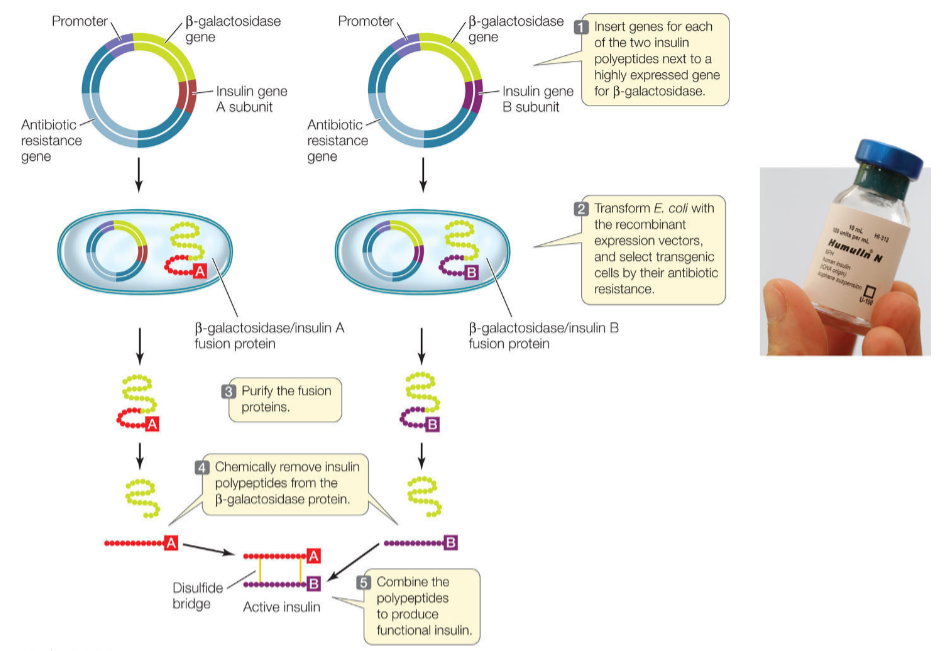
Gene Therapy

Diagnosis of Diseases

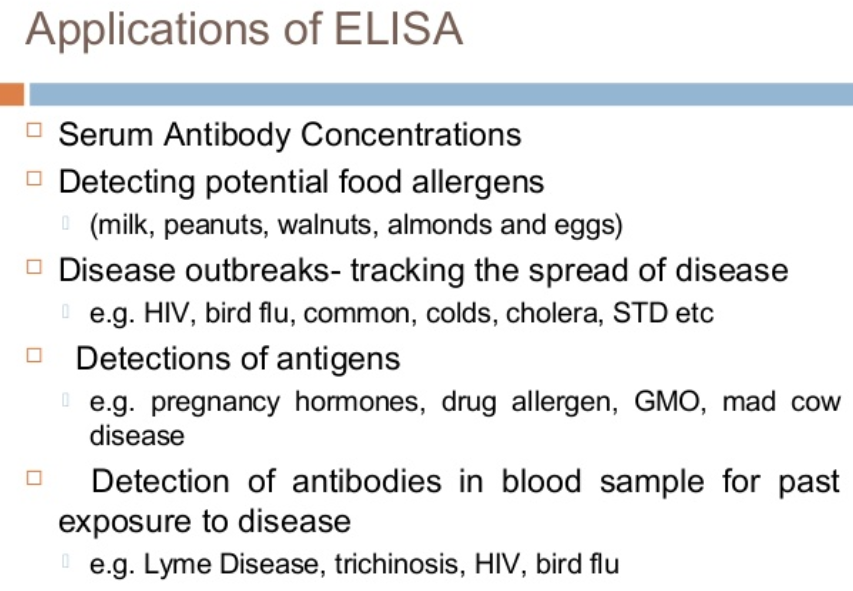
Use Of Recombinant Proteins As Medicines
APPLICATIONS OF BIOTECHNOLOGY IN MEDICINE
- Genetically Engineered Human Insulin
- 40-50 years back, diabetic patients were given insulin obtained from pigs which seemed to work fine but soon there were reports of severe allergies in some individuals from taking swine (pig) insulin.
- In 1954, Sanger determined the molecular structure of human insulin which contains 2 polypeptide chains A (21 amino acids) and chain B (30 amino acids), both connected by disulfide linkages to form functional human insulin of 51 amino acids.
- In 1983, Eli Lilly isolated the genetic sequence for chain A and chain B and transferred them into plasmid of the E.coli bacteria separately.
- They purified the chain A and chain B from separate bacterias and then they combined chain A and B externally by placing them in a sulphide rich medium so that the chain would form disulphide linkages and will now become genetically engineered functional human insulin against which there were rarely rarely any cases of allergies.
- Gene therapy involves replacing a faulty gene with a functional gene. Currently we are trying this for sickle cell anemia and for the first time gene therapy was given to a 4-year old girl (in 1990) suffering from severe combined immunodeficiency (SCID) disease.
- SCID occurs due to deficiency of Adenosine Deaminase enzyme, which is necessary for differentiation of white blood cells and in its absence the WBCs do not mature and individual becomes immunodeficient and falls ill quite easily. Even the slightest common cold could be fatal for such an individual.
- How was gene therapy given to this girl ?
First we isolated WBCs from her and then a functional ADA cDNA was introduced into her white blood cells using a retrovirus as vector. Then these WBCs were then again injected into her bone marrow. - Limitation: WBCs do not live for forever. The life span is generally 1-2 weeks. So we need to repeat the procedure every few weeks.
- Using rDNA technology, PCR and ELISA techniques we can detect any infection / diseases (like cancer, AIDS etc) at quite an early stage so that the treatment plan could be started as early as possible.
- PCR can amplify the very small amount of pathogenic genetic material and then it could be detected easily. PCR is now routinely done to detect HIV in suspected AIDS patients, to detect genetic mutations in cancer patients or patients suffering from other genetic disorders.
- Enzyme Linked Immunosorbent Assay (ELISA) is based on the interaction of antibody-antigen interaction. Infection of a pathogen can be confirmed by confirming presence of antibodies against the antigen or by detecting presence of antigens such as pathogenic proteins, glycoproteins etc.
- OKT-3 is used for preventing kidney transplantation rejection.
- ReoPro is used to prevent blood clots.
- Tissue Plasminogen Activator (TPA) to prevent acute myocardial infarction.
- Asparaginase for some cancers.
- DNase for treatment of cystic fibrosis.
- Blood Clotting Factor VII & IX : for treatment of haemophilia A and B respectively.
- Interferon alpha for hepatitis C.

Gene Therapy

Diagnosis of Diseases


Use Of Recombinant Proteins As Medicines
TRANSGENIC ANIMALS
- Animals which carry a foreign gene are known as transgenic animals.
- Transgenic animals are specifically developed to study how a particular gene is regulated.
- Many transgenic animals are used as a model for a particular disease to see how that disease affects the organism and how a particular medicine will react.
- Spare parts like heart, liver of pig for human use can be grown by genetic engineering.
- Transgenic animals are produced that synthesise specific biological products required to cure some of human diseases like the production of alpha-1-antitrypsin (via transgenic cow) is used to treat emphysema. In this case the transgenic cow will act as a bioreactor to produce the antitrypsin protein which will be purified from its milk.
- Clones of animals can be produced.
- Transgenic Mice
Mouse is the most preferred mammal for genetic engineering studies. Many transgenic mouse and knockout mice have been created to study the working mechanism of particular genes or diseases. - Transgenic Goats : are being used as bioreactors for various biomolecules specially the production of spider silk which is purified from goat's milk.
- Transgenic Sheep : Transgenic sheeps have been prepared to produce biomolecules like, blood clotting factor IX, antitrypsin etc. by fusing the transgenes into the mammary glands.
- Transgenic Chicken : Transgenic chickens resistant to the pathogen Avian Leukosis Virus (ALV) have been produced because ALV is a serious pathogen of chickens.
- Dogie a transgenic dog with super smelling power has been created which was used during the attack on world trade center in 2001 to recover injured people/ casualties after the building collapsed.
- ANDI : was the first transgenic monkey with DNA of fluorescent jellyfish in its genome.
- Transgenic Cattles : The 2 main objectives to produce transgenic cows are : increased milk/meat production and molecular farming (to use cattles as bioreactors). First transgenic cow is Rosie.
- Transgenic Pigs : Transgenic pigs have been created for increased meat production and to produce spare hearts, liver etc to cure disease where the last choice of treatment is usually organ transplantation. Pigs have been used for this purpose because the size of pigs organ, their morphology and anatomy are quite similar to humans.
Advantages Of Transgenic Animals
Examples Of Transgenic Animals
The photo shows two transgenic mice positioned either side of a plain mouse. The transgenic mice have been genetically modified so that they carry a green fluorescent protein which glows green under blue light.




POINTS TO KEEP IN MIND
- We synthesized the two chains A and B in separate bacteria because the complete human gene for insulin leads to production of a molecule known as pro insulin (Non-Functional) which has a polypeptide chain C in between the chain A and B. This chain C is a intron which is removed during transcription in eukaryotes but prokaryotes like bacteria have no enzyme to remove that intron so we identified the genetic sequence for chain A and B separately and then introduced them into separate bacteria so that we could get chain A and B separately. Creating disulfide linkages in lab is comparatively easy so we got fully functional human insulin.
- If gene replacement therapy is given at early embryonic stages, then it would be a permanent cure.
POINTS TO KEEP IN MIND
- We synthesized the two chains A and B in separate bacteria because the complete human gene for insulin leads to production of a molecule known as pro insulin (Non-Functional) which has a polypeptide chain C in between the chain A and B. This chain C is a intron which is removed during transcription in eukaryotes but prokaryotes like bacteria have no enzyme to remove that intron so we identified the genetic sequence for chain A and B separately and then introduced them into separate bacteria so that we could get chain A and B separately. Creating disulfide linkages in lab is comparatively easy so we got fully functional human insulin.
- If gene replacement therapy is given at early embryonic stages, then it would be a permanent cure.
APPLICATIONS OF BIOTECHNOLOGY IN MEDICINE
- Biotechnology ki medicine and research field me bahut sari major applications. Hum discuss karenge genetically engineered human insulin, gene therapy and use of biotechnology in diagnostic methods.
- Human insulin jab human body me banta hai toh usme 3 chains hoti hain : A, B and C but yeah pro-insulin non functional hai and functional insulin bnane ke liye iss chain C (an intron) ko remove kr diya jata hai so that we get function insulin composed of polypeptide chain A and B only.
- 40-50 saal pehle diabetic patients ko slaughtered pig se collect kiya hua insulin diya jata tha. Lekin kuch logon me severe allergic reactions ho gaye kyunki afterall wo insulin pig ka hai human ka nahi.
- Toh 1983 me Eli Liliy company ne insulin gene ki chain A and Chain B ke liye separate gene sequences ko differentE.coli bacteria ke plasmid me dala.
- Fir bacteria ki ek population se unhone chain A ko purify kiya and bacteria ki dusri population se chain B ko purify kiya and lab me in dono chains me disulfide linkages bna diya (this step is easy) jissye humein fully functional mature human insulin with only chain A and Chain B mila.
- 1990 me ek 4 saal ki bachi me ek enzyme adenosine deaminase (ADA) nahi bn rha tha jo ki WBCs ke maturation ke liye jaruri hota hai toh uss bachi ke WBCs fully develop nahi ho paye and usko SCID (Severe Combined Immunodeficiency Disease) bimari ho gyi.
- Ab humans hoshiyaar hain toh human ne ADA enzyme ka gene (ADA cDNA) nikala or retrovirus ko use karke iss gene segment ko uss bachi ke blood se jo humne WBCs isolate kiye thy, un WBCs me yeah gene daal diya.
- Ab WBCs khush kyunki unke pass function ADA gene hai and wo asani se mature hokar infections se protection provide karenge toh humne un WBCs ko wapis uss bachi ke blood me transfuse kiya.
- Dikkat ek hi thi ki WBCs ka life span kuch hi weeks ka hota hai. Toh jab new WBCs baney toh unme firse ADA gene functional nahi tha toh hume iss procedure ko har kuch weeks me repeat karna padega.
- Kuch saal pehle tak kisi bhi bimari ke liye hum jab blood ya urine test karte thy toh test positive lagbhag tab aata tha jab infection lagbhag apni charam seema pe hota tha. Aisa koi tareeka nahi tha jissey hum infection ko early stages par detect kr sake. Lekin thanks to biotechnology we have processes like PCR and ELISA jo infection ko bahut hi early stage me detect kr skte hain.
- PCR hum last chapter me discuss kar chuke hain and iski applications neeche image me given hai.
- ELISA aisi technique hai jo antigen-antibody reaction par based hai. Toh jab bhi infection hota hai toh humari body antibodies bnati hai. ELISA test me inhi antigens ya antibodies ko detect karte hain.
Genetically Engineered Human Insulin
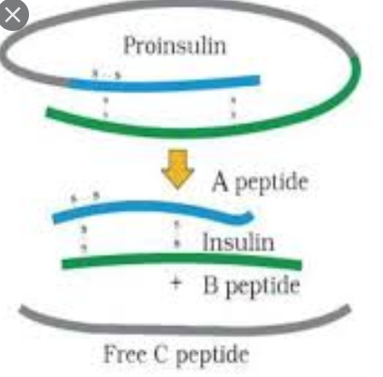
Gene Therapy
Applications In Diagnostics
ETHICAL ISSUES & BIOPIRACY
- Genetic modification of organisms can have disastrous, unpredictable results when these organisms are introduced into the ecosystem. So the Indian Government has set up organizations such as GEAC (Genetic Engineering Approval Committee), to make decisions regarding the validity of GM research and the safety of introducing GM-organisms for public service.
- Patent is the right granted by the Government to a producer to prevent others from using his product.
- An American company got patent rights on Basmati rice but the variety of Basmati had actually been derived from Indian farmer’s varieties.
- ELSI stands for Ethical, Legal and Social Issues. It's a term associated with the Human Genome project. Rapid advances in DNA-based research, human genetics, and their applications have resulted in new and complex ethical and legal issues for society.
- Several attempts have also been made to patent products based on Indian traditional herbal medicines. Example- turmeric, neem which have been used for centuries in India as antimicrobial agents were actually patented by some foreign companies whose consequence was that no one else can use these natural compounds to heal wounds which is totally absurd.
- Biopiracy is the term used to refer to the use of bio-resources by multinational companies and other organizations without proper authorization from the countries and people concerned without compensatory payment.
- Some nations are developing laws to prevent such unauthorized exploitation of their bio-resources and traditional knowledge.
- Brazzein is protein produced by the West African plant Pentadiplandra brazzeana which is nearly 2000 times sweeter than sugar. Local people have been using it for centuries but this protein was patented in the U.S.A. The gene was transferred to maize kernel after which were used for extraction of this protein and it led to serious implications for locals which could no longer use this plant protein.
- Who owns the genetically modified organism and can such organisms be patented as novel inventions?
- Are genetically modified foods/crops safe for human consumption?
- Wil there be unknown harmful effects on the people who consume GM products?
- Are genetically engineered crops (GM crops) safe for the environment?
- Can they harm other organisms and/or even the entire ecosystem in which they are introduced?
- What safety measures an organisation is taking to keep the genetic information of a person private?
- Should a pregnancy be ended if the fetus has a lethal mutation or a serious genetic disorder or a deformity due to a mutation?


Concerns from Biotechnology
The developments and use of biotechnology and genetic engineering of different organisms has raised a number of ethical, legal, and social issues like :
ETHICAL ISSUES & BIOPIRACY
- Genetic modification of organisms can have disastrous, unpredictable results when these organisms are introduced into the ecosystem. So the Indian Government has set up organizations such as GEAC (Genetic Engineering Approval Committee), to make decisions regarding the validity of GM research and the safety of introducing GM-organisms for public service.
- Patent is the right granted by the Government to a producer to prevent others from using his product.
- An American company got patent rights on Basmati rice but the variety of Basmati had actually been derived from Indian farmer’s varieties.
- ELSI stands for Ethical, Legal and Social Issues. It's a term associated with the Human Genome project. Rapid advances in DNA-based research, human genetics, and their applications have resulted in new and complex ethical and legal issues for society.
- Several attempts have also been made to patent products based on Indian traditional herbal medicines. Example- turmeric, neem which have been used for centuries in India as antimicrobial agents were actually patented by some foreign companies whose consequence was that no one else can use these natural compounds to heal wounds which is totally absurd.
- Biopiracy is the term used to refer to the use of bio-resources by multinational companies and other organizations without proper authorization from the countries and people concerned without compensatory payment.
- Some nations are developing laws to prevent such unauthorized exploitation of their bio-resources and traditional knowledge.
- Brazzein is protein produced by the West African plant Pentadiplandra brazzeana which is nearly 2000 times sweeter than sugar. Local people have been using it for centuries but this protein was patented in the U.S.A. The gene was transferred to maize kernel after which were used for extraction of this protein and it led to serious implications for locals which could no longer use this plant protein.
- Who owns the genetically modified organism and can such organisms be patented as novel inventions?
- Are genetically modified foods/crops safe for human consumption?
- Wil there be unknown harmful effects on the people who consume GM products?
- Are genetically engineered crops (GM crops) safe for the environment?
- Can they harm other organisms and/or even the entire ecosystem in which they are introduced?
- What safety measures an organisation is taking to keep the genetic information of a person private?
- Should a pregnancy be ended if the fetus has a lethal mutation or a serious genetic disorder or a deformity due to a mutation?


Concerns from Biotechnology
The developments and use of biotechnology and genetic engineering of different organisms has raised a number of ethical, legal, and social issues like :
APPLICATIONS OF BIOTECHNOLOGY IN MEDICINE
- Genetically Engineered Human Insulin
- 40-50 years back, diabetic patients were given insulin obtained from pigs which seemed to work fine but soon there were reports of severe allergies in some individuals from taking swine (pig) insulin.
- In 1954, Sanger determined the molecular structure of human insulin which contains 2 polypeptide chains A (21 amino acids) and chain B (30 amino acids), both connected by disulfide linkages to form functional human insulin of 51 amino acids.
- In 1983, Eli Lilly isolated the genetic sequence for chain A and chain B and transferred them into plasmid of the E.coli bacteria separately.
- They purified the chain A and chain B from separate bacterias and then they combined chain A and B externally by placing them in a sulphide rich medium so that the chain would form disulphide linkages and will now become genetically engineered functional human insulin against which there were rarely rarely any cases of allergies.
- Gene therapy involves replacing a faulty gene with a functional gene. Currently we are trying this for sickle cell anemia and for the first time gene therapy was given to a 4-year old girl (in 1990) suffering from severe combined immunodeficiency (SCID) disease.
- SCID occurs due to deficiency of Adenosine Deaminase enzyme, which is necessary for differentiation of white blood cells and in its absence the WBCs do not mature and individual becomes immunodeficient and falls ill quite easily. Even the slightest common cold could be fatal for such an individual.
- How was gene therapy given to this girl ?
First we isolated WBCs from her and then a functional ADA cDNA was introduced into her white blood cells using a retrovirus as vector. Then these WBCs were then again injected into her bone marrow. - Limitation: WBCs do not live for forever. The life span is generally 1-2 weeks. So we need to repeat the procedure every few weeks.
- Using rDNA technology, PCR and ELISA techniques we can detect any infection / diseases (like cancer, AIDS etc) at quite an early stage so that the treatment plan could be started as early as possible.
- PCR can amplify the very small amount of pathogenic genetic material and then it could be detected easily. PCR is now routinely done to detect HIV in suspected AIDS patients, to detect genetic mutations in cancer patients or patients suffering from other genetic disorders.
- Enzyme Linked Immunosorbent Assay (ELISA) is based on the interaction of antibody-antigen interaction. Infection of a pathogen can be confirmed by confirming presence of antibodies against the antigen or by detecting presence of antigens such as pathogenic proteins, glycoproteins etc.
- OKT-3 is used for preventing kidney transplantation rejection.
- ReoPro is used to prevent blood clots.
- Tissue Plasminogen Activator (TPA) to prevent acute myocardial infarction.
- Asparaginase for some cancers.
- DNase for treatment of cystic fibrosis.
- Blood Clotting Factor VII & IX : for treatment of haemophilia A and B respectively.
- Interferon alpha for hepatitis C.

Gene Therapy

Diagnosis of Diseases


Use Of Recombinant Proteins As Medicines
BIOWAR
- A war fought by bioweapons (biological organisms used as weapons) is a biowar. Following bioweapons have been used in the past :
- Anthrax developed by Britain
- Rickettsia sp.
- Hepatitis A
- Use of botulism toxin to kill nazi agents
- Use of anthrax spore by Germany
- Disease caused by bioweapons are : anthrax, small pox, plague, Q-fever, Tularemia, Viral Encephalitis, Botulinum, viral haemorrhagic fever etc.
- Protection against bioweapons : use respirator/ gas mask, protective shelter, decontamination, vaccination, antibiotics.

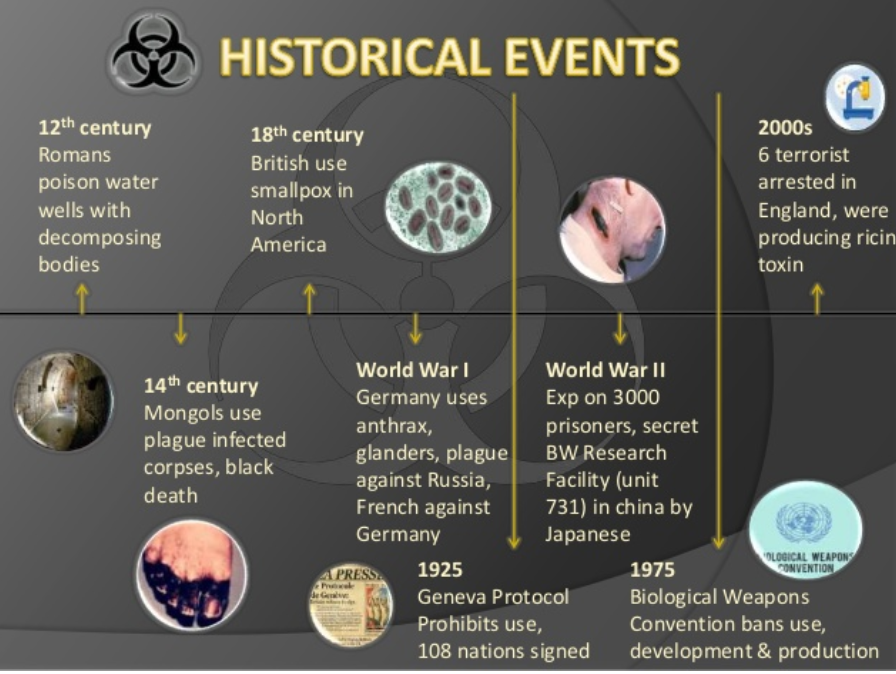
BIOWAR
- A war fought by bioweapons (biological organisms used as weapons) is a biowar. Following bioweapons have been used in the past :
- Anthrax developed by Britain
- Rickettsia sp.
- Hepatitis A
- Use of botulism toxin to kill nazi agents
- Use of anthrax spore by Germany
- Disease caused by bioweapons are : anthrax, small pox, plague, Q-fever, Tularemia, Viral Encephalitis, Botulinum, viral haemorrhagic fever etc.
- Protection against bioweapons : use respirator/ gas mask, protective shelter, decontamination, vaccination, antibiotics.


POINTS TO KEEP IN MIND
- We synthesized the two chains A and B in separate bacteria because the complete human gene for insulin leads to production of a molecule known as pro insulin (Non-Functional) which has a polypeptide chain C in between the chain A and B. This chain C is a intron which is removed during transcription in eukaryotes but prokaryotes like bacteria have no enzyme to remove that intron so we identified the genetic sequence for chain A and B separately and then introduced them into separate bacteria so that we could get chain A and B separately. Creating disulfide linkages in lab is comparatively easy so we got fully functional human insulin.
- If gene replacement therapy is given at early embryonic stages, then it would be a permanent cure.
SUMMARY
- Biotechnology has given to humans several useful products by using microbes, plants, animals and their metabolic machinery. Recombinant DNA technology has made it possible to engineer microbes, plants and animals such that they have novel capabilities.
- Genetically Modified Organisms have been created by using methods other than natural methods to transfer one or more genes from one organism to another, generally using techniques such as recombinant DNA technology.
- GM plants have been useful in increasing crop yields, reducing postharvest losses and make crops more tolerant of stresses.
- There are several GM crop plants with improved nutritional value of foods and reduced the reliance on chemical pesticides (pest-resistant crops).
- Recombinant DNA technological processes have made immense impact in the area of healthcare by enabling mass production of safe and more effective therapeutics.
- Since the recombinant therapeutics are identical to human proteins, they do not induce unwanted immunological responses and are free from risk of infection as was observed in case of similar products isolated from non-human sources.
- Human insulin is made in bacteria yet its structure is absolutely identical to that of the natural molecule.
- Transgenic animals are also used to understand how genes contribute to the development of a disease by serving as models for human diseases, such as cancer, cystic fibrosis, rheumatoid arthritis and Alzheimer’s. Gene therapy is the insertion of genes into an individual’s cells and tissues to treat diseases especially hereditary diseases.
- It does so by replacing a defective mutant allele with a functional one or gene targeting which involves gene amplification.
- Viruses that attack their hosts and introduce their genetic material into the host cell as part of their replication cycle are used as vectors to transfer healthy genes or more recently portions of genes.
- The current interest in the manipulation of microbes, plants, and animals has raised serious ethical questions.
SUMMARY
- Biotechnology has given to humans several useful products by using microbes, plants, animals and their metabolic machinery. Recombinant DNA technology has made it possible to engineer microbes, plants and animals such that they have novel capabilities.
- Genetically Modified Organisms have been created by using methods other than natural methods to transfer one or more genes from one organism to another, generally using techniques such as recombinant DNA technology.
- GM plants have been useful in increasing crop yields, reducing postharvest losses and make crops more tolerant of stresses.
- There are several GM crop plants with improved nutritional value of foods and reduced the reliance on chemical pesticides (pest-resistant crops).
- Recombinant DNA technological processes have made immense impact in the area of healthcare by enabling mass production of safe and more effective therapeutics.
- Since the recombinant therapeutics are identical to human proteins, they do not induce unwanted immunological responses and are free from risk of infection as was observed in case of similar products isolated from non-human sources.
- Human insulin is made in bacteria yet its structure is absolutely identical to that of the natural molecule.
- Transgenic animals are also used to understand how genes contribute to the development of a disease by serving as models for human diseases, such as cancer, cystic fibrosis, rheumatoid arthritis and Alzheimer’s. Gene therapy is the insertion of genes into an individual’s cells and tissues to treat diseases especially hereditary diseases.
- It does so by replacing a defective mutant allele with a functional one or gene targeting which involves gene amplification.
- Viruses that attack their hosts and introduce their genetic material into the host cell as part of their replication cycle are used as vectors to transfer healthy genes or more recently portions of genes.
- The current interest in the manipulation of microbes, plants, and animals has raised serious ethical questions.
ETHICAL ISSUES & BIOPIRACY
- Genetic engineering me human literally DNA ke sath khel rahe hain and jaise ki pehle btaya, transgenic animals suffer quite a bit in the lab. Therefore, the Indian Government has set up organisations such as GEAC (Genetic Engineering Approval Committee), which will make decisions regarding the validity of GM research and the safety of introducing GM-organisms for public services.
- Biopiracy yeah ki foreign companies ko patent mil jata hai ki bhyii yeah cheez inka invention toh koi or inki permission ke bina isko use nahi karega jabki wo companies chori kr rhi hoti hai. For example : apun India me haldi ko wound healing ke liye kitne saalo se use kar rahe hain. Ab ek foreign company aaie, usne haldi ke wo component jo wound heal karne me help karta hai usko study karke bola ki ji ye hamari new research hai and ab meri company haldi ko patent krana chahti jiske baad koi bhi isko bina hmari permission ke liye iski medicinal properties use na kare. Toh yeah toh galat hai.
- Same aise hi basmati rice ki varieties ke sath hua tha and with many other naturally available compounds which are discussed below.
- Iss part se generally koi question nahi pucha jata hai toh biopatent ki jyada details study karne ki jarurat nahi hai or nahi details apne syllabus me. 2-4 examples hain ncert ke bas vhi study karna hai and they are also discussed below.
ETHICAL ISSUES & BIOPIRACY
- Genetic modification of organisms can have disastrous, unpredictable results when these organisms are introduced into the ecosystem. So the Indian Government has set up organizations such as GEAC (Genetic Engineering Approval Committee), to make decisions regarding the validity of GM research and the safety of introducing GM-organisms for public service.
- Patent is the right granted by the Government to a producer to prevent others from using his product.
- An American company got patent rights on Basmati rice but the variety of Basmati had actually been derived from Indian farmer’s varieties.
- ELSI stands for Ethical, Legal and Social Issues. It's a term associated with the Human Genome project. Rapid advances in DNA-based research, human genetics, and their applications have resulted in new and complex ethical and legal issues for society.
- Several attempts have also been made to patent products based on Indian traditional herbal medicines. Example- turmeric, neem which have been used for centuries in India as antimicrobial agents were actually patented by some foreign companies whose consequence was that no one else can use these natural compounds to heal wounds which is totally absurd.
- Biopiracy is the term used to refer to the use of bio-resources by multinational companies and other organizations without proper authorization from the countries and people concerned without compensatory payment.
- Some nations are developing laws to prevent such unauthorized exploitation of their bio-resources and traditional knowledge.
- Brazzein is protein produced by the West African plant Pentadiplandra brazzeana which is nearly 2000 times sweeter than sugar. Local people have been using it for centuries but this protein was patented in the U.S.A. The gene was transferred to maize kernel after which were used for extraction of this protein and it led to serious implications for locals which could no longer use this plant protein.
- Who owns the genetically modified organism and can such organisms be patented as novel inventions?
- Are genetically modified foods/crops safe for human consumption?
- Wil there be unknown harmful effects on the people who consume GM products?
- Are genetically engineered crops (GM crops) safe for the environment?
- Can they harm other organisms and/or even the entire ecosystem in which they are introduced?
- What safety measures an organisation is taking to keep the genetic information of a person private?
- Should a pregnancy be ended if the fetus has a lethal mutation or a serious genetic disorder or a deformity due to a mutation?


Concerns from Biotechnology
The developments and use of biotechnology and genetic engineering of different organisms has raised a number of ethical, legal, and social issues like :
BIOWAR
- A war fought by bioweapons (biological organisms used as weapons) is a biowar. Following bioweapons have been used in the past :
- Anthrax developed by Britain
- Rickettsia sp.
- Hepatitis A
- Use of botulism toxin to kill nazi agents
- Use of anthrax spore by Germany
- Disease caused by bioweapons are : anthrax, small pox, plague, Q-fever, Tularemia, Viral Encephalitis, Botulinum, viral haemorrhagic fever etc.
- Protection against bioweapons : use respirator/ gas mask, protective shelter, decontamination, vaccination, antibiotics.


SUMMARY
- Biotechnology has given to humans several useful products by using microbes, plants, animals and their metabolic machinery. Recombinant DNA technology has made it possible to engineer microbes, plants and animals such that they have novel capabilities.
- Genetically Modified Organisms have been created by using methods other than natural methods to transfer one or more genes from one organism to another, generally using techniques such as recombinant DNA technology.
- GM plants have been useful in increasing crop yields, reducing postharvest losses and make crops more tolerant of stresses.
- There are several GM crop plants with improved nutritional value of foods and reduced the reliance on chemical pesticides (pest-resistant crops).
- Recombinant DNA technological processes have made immense impact in the area of healthcare by enabling mass production of safe and more effective therapeutics.
- Since the recombinant therapeutics are identical to human proteins, they do not induce unwanted immunological responses and are free from risk of infection as was observed in case of similar products isolated from non-human sources.
- Human insulin is made in bacteria yet its structure is absolutely identical to that of the natural molecule.
- Transgenic animals are also used to understand how genes contribute to the development of a disease by serving as models for human diseases, such as cancer, cystic fibrosis, rheumatoid arthritis and Alzheimer’s. Gene therapy is the insertion of genes into an individual’s cells and tissues to treat diseases especially hereditary diseases.
- It does so by replacing a defective mutant allele with a functional one or gene targeting which involves gene amplification.
- Viruses that attack their hosts and introduce their genetic material into the host cell as part of their replication cycle are used as vectors to transfer healthy genes or more recently portions of genes.
- The current interest in the manipulation of microbes, plants, and animals has raised serious ethical questions.